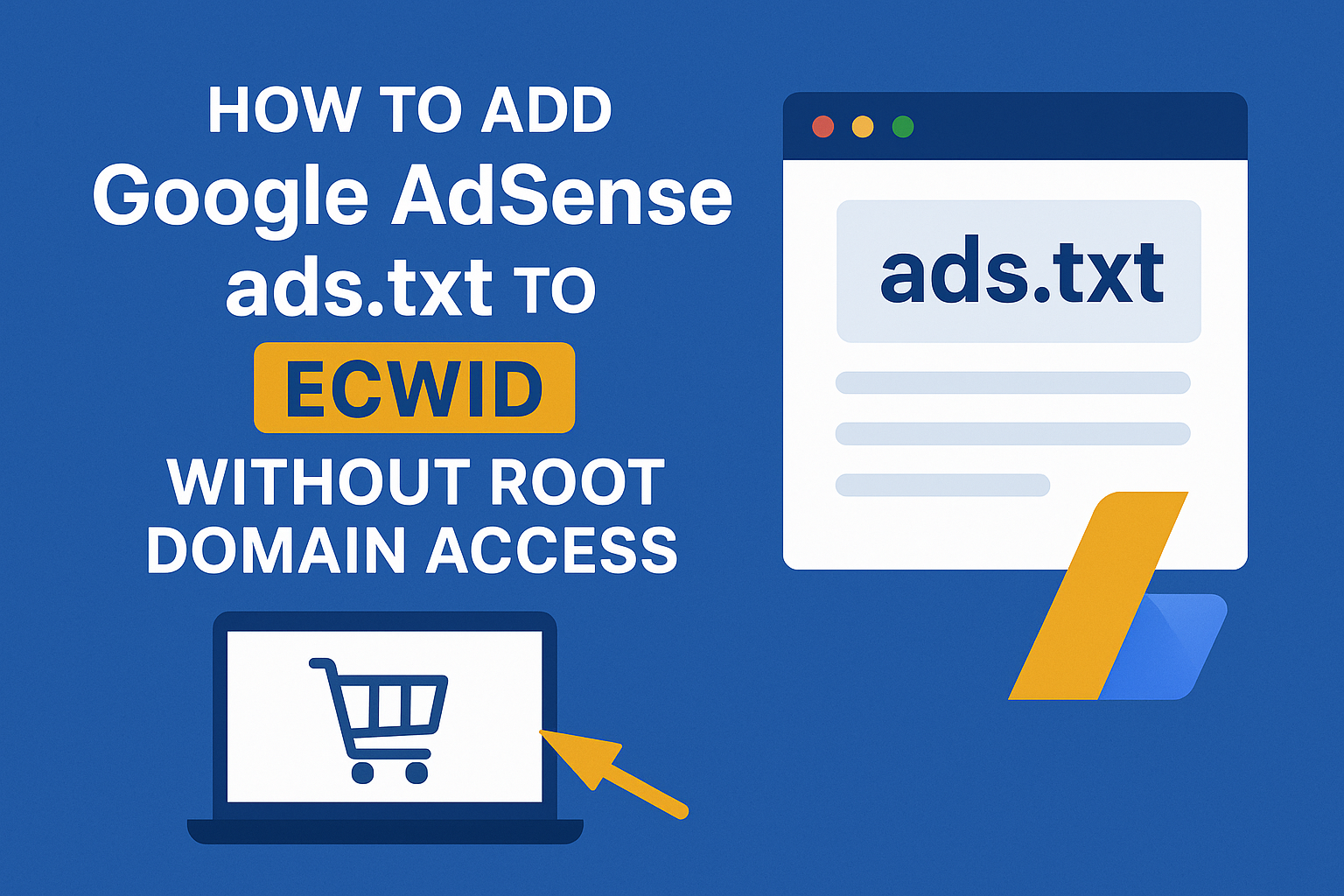How to Add Google AdSense ads.txt to Ecwid or Any Website Builder Without Root Domain Access
Adding a Google AdSense ads.txt file is essential for publishers who want to maximize ad revenue and avoid the frustrating “Earnings at risk” warning in their AdSense dashboard. But if your website runs on Ecwid, Shopify Lite, Wix, Squarespace, or other hosted site builders, you may realize you don’t have access to your root domain’s file structure. That means you can’t just upload ads.txt directly.
The good news is that there’s a proven solution. Even if your store is fully hosted on Ecwid Instant Site with no root directory access, you can still publish ads.txt using Netlify as a proxy. This guide will show you the exact steps, why it works, and how to do it without hurting your SEO rankings or breaking your site.
Why ads.txt Matters for Google AdSense Publishers
The ads.txt file is part of the IAB Tech Lab’s Authorized Digital Sellers initiative. It’s a simple text file at the root of your domain (https://yourdomain.com/ads.txt) that lists all ad networks authorized to sell your ad space.
Main benefits of ads.txt
- Stops unauthorized reselling: Only approved partners can sell your inventory.
- Builds advertiser trust: Buyers prefer verified publishers.
- Boosts potential earnings: More demand from quality advertisers.
- Meets Google’s requirements: Removes the “Earnings at risk” warning in AdSense.
Without this file, you risk lower bids, fewer ads served, and reduced revenue.
Why Ecwid and Other Website Builders Make This Difficult
Platforms like Ecwid, Wix, Shopify Lite, and Squarespace host your store on their own servers. While they allow you to connect a custom domain such as shopsalesja.com, you don’t get access to the root directory, FTP, or file manager. That means you can’t simply upload an ads.txt file.
Common limitations
- No root folder access
- No FTP or SFTP login
- Restrictions on uploading arbitrary files
Example: An Ecwid Instant Site may look like https://yourstore.company.site. Even when mapped to a custom domain, the hosting remains with Ecwid, leaving you unable to upload ads.txt directly.
The Workaround: Host ads.txt on Netlify as a Proxy
The solution is to use Netlify as a lightweight proxy. You host the ads.txt file on Netlify, point your domain there, and let Netlify forward all traffic to your Ecwid (or other builder) site. Your visitors still see your store, but Google sees ads.txt correctly at the root of your domain.
Why this works
- Restores control over your root directory without moving platforms.
- Allows you to serve additional files (robots.txt, verification files, etc.).
- Keeps your SEO intact by returning 200 status codes for all proxied pages.
Step-by-Step Guide to Adding ads.txt Without Root Access
Step 1: Create Your ads.txt File
Open any text editor (Notepad, VS Code, Sublime) and paste the exact line Google AdSense provides you. For example:
google.com, pub-1234567890123456, DIRECT, f08c47fec0942fa0
Save it as ads.txt.
Step 2: Create a _redirects File
In the same folder, create a plain text file named _redirects (no extension). Add this line:
/* https://yourstore.company.site/:splat 200
Replace yourstore.company.site with your Ecwid Instant Site URL.
Step 3: Deploy on Netlify
- Go to Netlify and sign up for a free account.
- Click “Add new site” → “Deploy manually”.
- Drag and drop your folder containing
ads.txtand_redirects.
Step 4: Update Your DNS
Log in to your domain registrar (e.g., GoDaddy, Namecheap, OpenSRS) and update your A records:
@→ 75.2.60.5www→ 75.2.60.5
Save and wait for DNS propagation (can take a few minutes to 48 hours).
Step 5: Verify
Visit https://yourdomain.com/ads.txt. If you see your file, you’ve done it correctly. Google AdSense usually removes the “Earnings at risk” warning within 3–7 days.
SEO Considerations
This method uses a 200 proxy, which tells Google that your site is intact on your domain. That means no loss of backlinks, search engine indexing, or rankings. Avoid using 301 or 302 redirects on your main store pages, as they may impact SEO.
Another advantage is flexibility: you can easily add other verification files (Google Search Console, Pinterest, Bing Webmaster Tools) directly to Netlify without touching Ecwid or your website builder.
Common Mistakes to Avoid
- Wrong redirect type: Must be
200, not301or302. - DNS errors: Ensure both
@andwwwrecords point to Netlify. - No SSL setup: Enable free HTTPS in Netlify for trust and SEO.
- Typos in _redirects: Always use the exact Ecwid Instant Site URL.
Frequently Asked Questions
Will this method also work for Wix, Squarespace, or Shopify Lite?
Yes, as long as your platform works behind a proxy and you can point your domain to Netlify.
Do I need a paid Netlify plan?
No. Netlify’s free plan is enough for ads.txt hosting and proxying.
Will my SEO rankings drop?
No, as long as you set it up correctly with 200 proxy redirects.
How long before AdSense accepts my ads.txt?
Usually 3–7 days after Google detects the file.
Final Thoughts
This solution is one of the easiest and most reliable ways to add Google AdSense ads.txt to Ecwid or any hosted site builder without root domain access. You get full control over root-level files, your store remains intact, and your SEO is safe.
For more tutorials and insights, check out my blog or visit Shop Sales JA for real-world eCommerce solutions.
You May Also Like
Best AI Writing Tools for US Freelancers in 2025: Long-Term Text Generators That Boost Productivity

